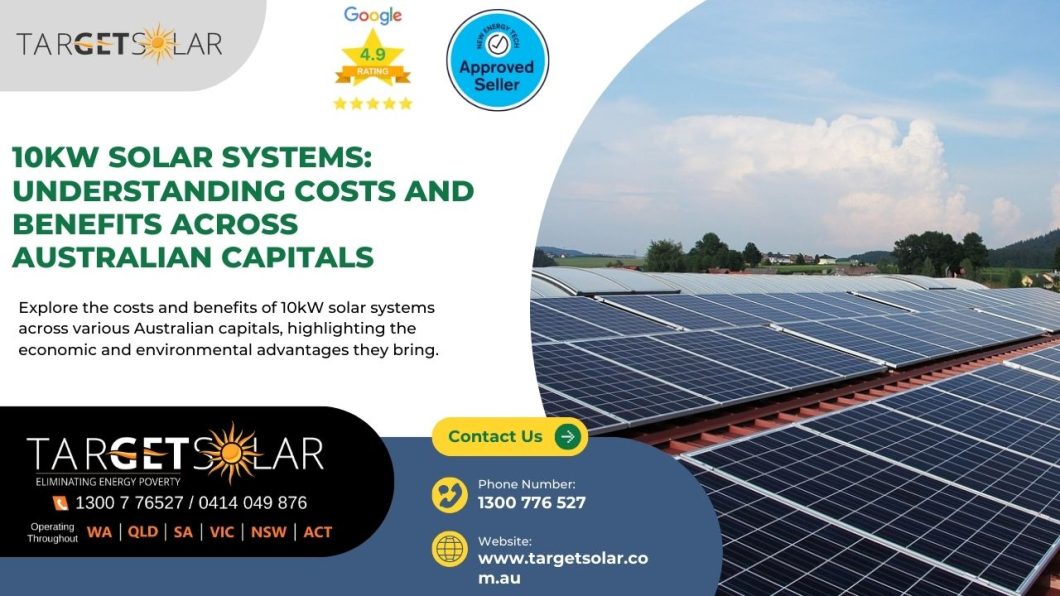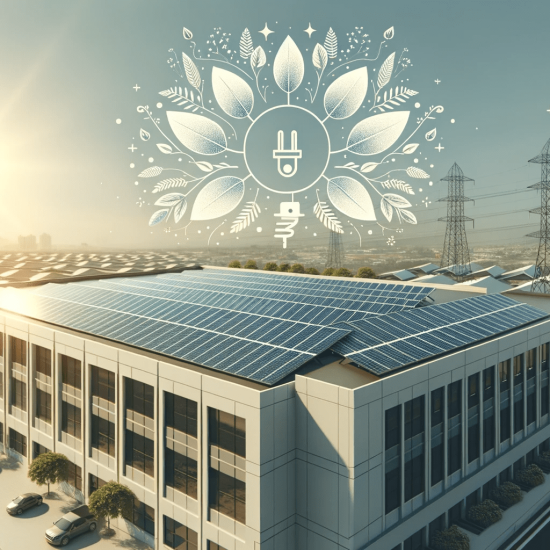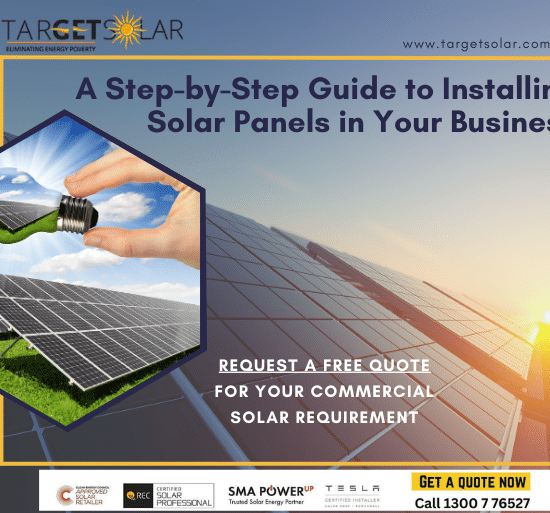Introduction: The Rise of Solar Energy in Australia
Australia’s abundant sunshine makes it an ideal location for solar power generation. As energy costs rise and environmental awareness grows, more homeowners and small businesses are turning to solar energy as a viable alternative. Among the various system sizes available, the 10kW solar system has emerged as a popular choice for its balance between cost and capability. This blog post explores the costs, benefits, and potential savings of installing a 10kW solar system across major Australian capital cities.
Section 1: What is a 10kW Solar System?
A 10kW solar system typically consists of about 25 to 30 solar panels, assuming each panel produces around 330 to 400 watts. This system size requires approximately 80 square meters of roof space and is capable of generating substantial electricity to cover the energy needs of a large household or a small business. It’s particularly suited for properties with high daytime energy usage or for those looking to reduce significant energy bills.
Section 2: Cost Analysis Across Australian Capitals
The cost of a 10kW solar system can vary significantly depending on location due to factors like logistics, installation challenges, and local market competition. As of the latest data:
Note: this data should only use for reference. This is not an actual rate.
- Sydney, NSW: The average cost is around $7,950.
- Melbourne, VIC: Typical installation costs are about $8,540.
- Brisbane, QLD: Expect to pay approximately $9,220.
- Perth, WA: The average price is near $9,760.
- Adelaide, SA: Costs are typically around $8,530.
- Canberra, ACT: Installation might cost about $8,790.
- Hobart, TAS: The average installation cost is $11,420.
- Darwin, NT: This city sees the highest costs at about $13,060.
These prices can fluctuate based on the specifics of the installation site, such as roof accessibility, the type of panels used, and whether additional upgrades like inverters are necessary.
Section 3: Energy Production and Savings
The energy production of a 10kW system also varies by location due to factors like solar irradiance, panel orientation, and potential shading. Here’s what you might expect:
- Adelaide: Generates about 36-41 kWh per day.
- Brisbane: Typically produces 39-41 kWh per day.
- Canberra: Daily generation ranges from 36-41 kWh.
- Darwin: Has the highest output at 42-46 kWh per day.
- Hobart: Produces about 29-33 kWh per day.
- Melbourne: Outputs range from 31-36 kWh daily.
- Perth: Generates about 40-44 kWh per day.
- Sydney: Typically sees 34-38 kWh per day.
These outputs translate into significant savings on electric bills, especially in locations with higher rates of sunlight and energy costs. For instance, homes in Darwin can see quicker returns on investment due to higher daily energy production.
Section 4: The Financial Return and Payback Period
Investing in a 10kW solar system not only helps reduce carbon footprint but also offers financial returns through savings. The average payback period varies:
- Sydney: About 4.7 to 3.1 years.
- Brisbane: Ranges from 6.0 to 4.0 years.
- Melbourne: Between 6.8 and 4.4 years.
- Perth: Approximately 5.2 to 3.4 years.
- Adelaide: From 3.9 to 2.6 years.
- Hobart: Between 6.3 to 4.0 years.
- Canberra: About 5.1 to 3.4 years.
- Darwin: Ranges from 6.3 to 4.6 years.
These figures are influenced by local electricity prices, solar feed-in tariffs, and personal energy consumption patterns.
Section 5: Incentives and Rebates
Australia offers various federal and state incentives that can further reduce the upfront cost of a solar system. These incentives include Small-scale Technology Certificates (STCs), feed-in tariffs, and local grants. These incentives are crucial for making solar power more accessible and affordable. Our expert team will help you from start to end with rebates and installation process.
Section 6: Enhancing Energy Freedom with Solar Batteries and Upgrades
Adding a Battery to Your Solar System
For those looking to enhance their energy independence and increase savings, adding a battery to a 10kW solar system is a transformative step. Solar batteries store excess energy generated during peak sunlight hours, which can then be used during the evening or on cloudy days, reducing reliance on the grid and increasing energy security.
Here are the key benefits of integrating a battery with your solar system:
- Increased Energy Independence: With a battery, you can cover your energy needs even when the sun isn’t shining, making your home or business less dependent on grid electricity.
- Greater Savings: By using stored solar energy during peak tariff times, you effectively avoid high electricity rates, further reducing your energy bills.
- Backup Power: In the event of a power outage, a solar battery can provide crucial backup power, keeping essential appliances running smoothly.
Upgrading Your Existing Solar System
Upgrading your existing solar system can also lead to greater efficiency and potentially more savings. This could involve replacing older solar panels with newer, more efficient models, or expanding the size of your system to generate more power. Particularly, upgrading from blue to black solar panels can enhance the aesthetic appeal of your solar setup while improving light absorption and efficiency.
Here’s why upgrading is a wise choice:
- Increased Property Value: Upgraded solar systems can increase the market value of your property, offering a compelling selling point that appeals to eco-conscious buyers.
- Better Efficiency: Modern solar panels are more efficient at converting sunlight into energy, which means more power generation and greater savings on your energy bills.
- Potential Earnings from Feed-in Tariffs: With a larger or more efficient system, you’ll likely generate more power than you consume. You can sell this surplus energy back to the grid through feed-in tariffs, turning your solar system into a source of income.
Making the Most of Feed-in Tariffs
Feed-in tariffs (FiTs) are payments made to households or businesses for the excess electricity they generate with their solar system and feed back into the public grid. These tariffs vary by state and energy provider but can significantly enhance the financial returns of owning a solar system.
To maximize the benefits of FiTs, consider the following:
- Understand Your Tariff: Check with your local energy provider for the latest feed-in tariff rates and how they apply to your bill.
- Monitor Your Energy Production and Usage: Regular monitoring can help you understand your energy habits and optimize your consumption to maximize feed-in earnings.
- Consult with Experts: Solar energy consultants can provide tailored advice on how to adjust your energy usage and system setup to take full advantage of FiTs.
Conclusion: Enhancing Your Solar Investment
By adding a battery or upgrading your existing system, you can significantly enhance the benefits of your solar investment. These enhancements not only increase energy independence and savings but also contribute to a sustainable energy future. Whether you’re looking to add storage capabilities with a battery or increase your earnings through improved efficiency and feed-in tariffs, the path to a more sustainable and economically beneficial solar solution is clear.
Ready to take your solar system to the next level? Contact Target Solar today to discuss battery additions and upgrades for your existing setup. Our experts are here to guide you through every step of the process, ensuring you maximize your solar investment for greater energy freedom and financial return.
- Phone: 1300 776 527
- Email: info@targetsolar.com.au
- Website: Explore Solar Options with Target Solar
Empower your energy future with Target Solar. Upgrade today and start enjoying the added benefits and savings that come with advanced solar technology and smart energy management!




